Suzanne Treister
2018
MI3 (Machine Intelligence 3)

MI3 diagram/algorithm/set of instructions for Google MI (Machine
Intelligence) to implement project.
Process
A. Machine Intelligence at Google data sweeps online material, compiling 3 datasets, in order to create and train 3 independent self learning Machine Intelligences.
Dataset 1.
From recent and historical books and texts by writers critical of the technological society; e.g. Jean-Jacques Rousseau, Ralph Waldo Emerson, Henry David Thoreau, Henri Zisly, Martin Heidegger, Theodore Adorno and Max Horkheimer, Jacques Ellul, Lewis Mumford, Joseph Weizenbaum, Ivan Illich, Guy Debord, Neil Postman, Langdon Winner, Fredy Perlman, Theodore Kaczynski, John Zerzan, David Watson, Hakim Bey, Bob Black and Derrick Jenson.
To create and train a self-critical Machine Intelligence.
Dataset 2.
From all US military departments' documents.
To create and train an autonomous Machine Intelligence for determining military policy, strategy and action.
Dataset 3.
From all online texts on religious belief systems.
To create and train a Machine Intelligence with multiple religious beliefs.
B. Data output by the 3 Machine Intelligences is synthesised and collated by Google MI into 7 bodies of text.
C. These 7 text outputs are converted by Google MI into 7 images.
Outcome
D. Google MI converts the 7 images via Neural Style Transfer, using 7 selected works by artist William Blake as Style Images to create 7 new works of art.
E. In the spirit of the grass roots internet of the 1990s the 7 artworks are presented here for copyright free download and print.
The works are images containing the original source data of their own making, ghosts of the 3 created Machine Intelligences transmuted into the style of a dead luminary artist, visions which may travel into the future, inserting themselves into homes and spaces across the globe, witnesses, for an unascertainable time span, of whatever is to come.
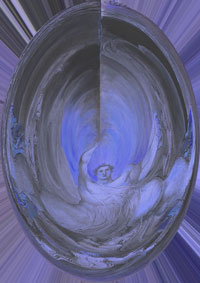 |
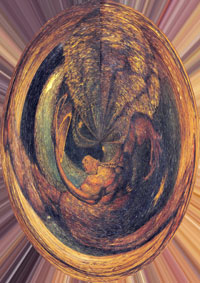 |
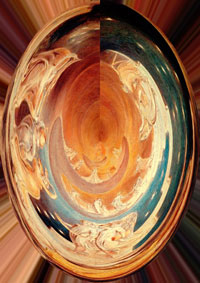 |
 |
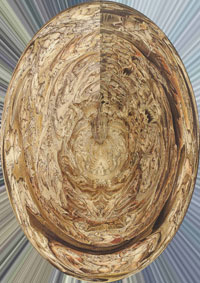 |
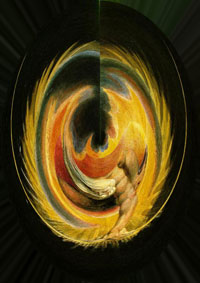 |
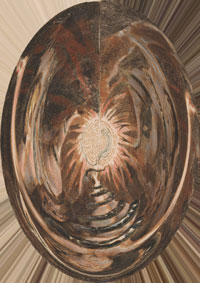 |
|---|---|---|---|---|---|---|
CLICK ON AN IMAGE ABOVE FOR HIGH RES DOWNLOAD PAGE |
||||||
| Notes: Machine Intelligence at Google https://research.google.com/pubs/MachineIntelligence.html Artists and Machine Intelligence AMI is a program at Google that brings artists and engineers together to realize projects using Machine Intelligence. By supporting this emerging form of artistic collaboration we open our research to new ways of thinking about and working with intelligent systems. https://ami.withgoogle.com/ Artists and Machine Intelligence blog https://medium.com/artists-and-machine-intelligence Artists and Machine Intelligence AMI is a program at Google that brings together artists and engineers to realize projects using Machine Intelligence. Works are developed together alongside artists’ current practices and shown at galleries, biennials, festivals, or online. https://medium.com/artists-and-machine-intelligence/what-is-ami-96cd9ff49dde Skynet (Terminator) https://en.wikipedia.org/wiki/Skynet_(Terminator) Elon Musk worries Skynet is only five years off, cnet, November 19, 2014 https://www.cnet.com/news/elon-musk-worries-skynet-is-only-five-years-off/ Artistic Style Transfer with Convolutional Neural Network https://medium.com/data-science-group-iitr/artistic-style-transfer-with-convolutional-neural-network-7ce2476039fd Neural Artistic Style Transfer_ A Comprehensive Look https://medium.com/artists-and-machine-intelligence/neural-artistic-style-transfer-a-comprehensive-look-f54d8649c199 Collaborating with intelligent machines, by Lucy Sollitt, Apr 21, 2017 https://medium.com/intersections-arts-and-digital-culture-in-the-uk/collaborating-with-intelligent-machines-cb5ecf32c98d How the CIA made Google, By Nafeez Ahmed Part 1, Jan 22, 2015 https://medium.com/insurge-intelligence/how-the-cia-made-google-e836451a959e How the CIA made Google (Why Google made the NSA), INSURGE intelligence, By Nafeez Ahmed Part 2 https://medium.com/insurge-intelligence/why-google-made-the-nsa-2a80584c9c1 Google's DeepMind https://deepmind.com/about/ Google's Tensorflow https://www.tensorflow.org/ Interview between Suzanne Treister and Kenric McDowell at Google Machine Intelligence Towards a Poetics of Artificial Superintelligence, by Nora N. Khan, Sep 25, 2015 https://medium.com/after-us/towards-a-poetics-of-artificial-superintelligence-ebff11d2d249 Romanticism emerged as a response to the disillusionment with the Enlightenment values of reason and order in the aftermath of the French Revolution of 1789. ...As articulated by the British statesman Edmund Burke in a 1757 treatise and echoed by the French philosopher Denis Diderot a decade later, “all that stuns the soul, all that imprints a feeling of terror, leads to the sublime.” https://www.metmuseum.org/toah/hd/roma/hd_roma.htm William Blake (28 November 1757– 12 August 1827) was an English poet, painter, and printmaker. Largely unrecognised during his lifetime, Blake is now considered a seminal figure in the history of the poetry and visual arts of the Romantic Age. What he called his prophetic works were said by 20th-century critic Northrop Frye to form "what is in proportion to its merits the least read body of poetry in the English language". His visual artistry led 21st-century critic Jonathan Jones to proclaim him "far and away the greatest artist Britain has ever produced". In 2002, Blake was placed at number 38 in the BBC's poll of the 100 Greatest Britons. Although he lived in London his entire life (except for three years spent in Felpham), he produced a diverse and symbolically rich œuvre, which embraced the imagination as "the body of God" or "human existence itself". Although Blake was considered mad by contemporaries for his idiosyncratic views, he is held in high regard by later critics for his expressiveness and creativity, and for the philosophical and mystical undercurrents within his work. His paintings and poetry have been characterised as part of the Romantic movement and as "Pre-Romantic". Reverent of the Bible but hostile to the Church of England (indeed, to almost all forms of organised religion), Blake was influenced by the ideals and ambitions of the French and American Revolutions. Though later he rejected many of these political beliefs, he maintained an amiable relationship with the political activist Thomas Paine; he was also influenced by thinkers such as Emanuel Swedenborg. Despite these known influences, the singularity of Blake's work makes him difficult to classify. The 19th-century scholar William Rossetti characterised him as a "glorious luminary", and "a man not forestalled by predecessors, nor to be classed with contemporaries, nor to be replaced by known or readily surmisable successors". https://en.wikipedia.org/wiki/William_Blake |
||||||